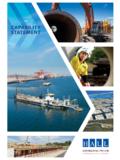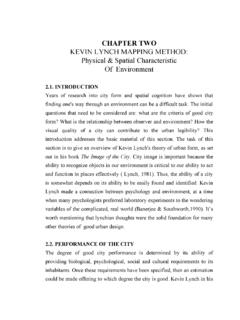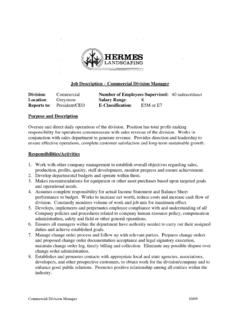Transcription of RR952 - A review of the literature on effective leadership ...
1 Health and safety Executive A review of the literature on effective leadership behaviours for safety Prepared by the Health and safety Laboratory for the Health and safety Executive RR952 Research Report Health and safety Executive A review of the literature on effective leadership behaviours for safety Chrysanthi Lekka Nicola Healey Harpur Hill Buxton Derbyshire SK17 9JN There is widespread agreement between industry, regulators, academics and the press that leadership is a key component of a safe organisation. This view is widely supported by findings from almost all major incident inquiries and investigations. However, the widespread agreement that leadership is central to safety does not extend to how leadership should deliver safety , what needs to be done, and rather importantly, who should be doing it. While there is considerable literature on leadership , very little of this addresses the issue of safety , particularly in the major hazard sector.
2 This report and the work it describes were funded by the Health and safety Executive (HSE). Its contents, including any opinions and/or conclusions expressed, are those of the authors alone and do not necessarily reflect HSE policy. HSE Books Crown copyright 2012 First published 2012 You may reuse this information (not including logos) free of charge in any format or medium, under the terms of the Open Government Licence. To view the licence visit , write to the Information Policy Team, The National Archives, Kew, London TW9 4DU, or email Some images and illustrations may not be owned by the Crown so cannot be reproduced without permission of the copyright owner. Enquiries should be sent to ii KEY MESSAGES Transformational and transactional theories of leadership have received considerable empirical support suggesting that they can be appropriate for the effective management of safety .
3 Other leadership theories, such as authentic leadership , whilst holding great promise lack empirical research regarding their impact on safety . Managers can have a positive influence on safety outcomes by articulating a clear vision for safety , and motivating employees to achieve it, acting as role models and showing concern for the welfare of employees ( transformational leadership ), communicating and setting clear goals and standards for safety , monitoring and recognising positive safety behaviours ( transactional leadership ). effective leaders are coaching-oriented, supportive, provide the necessary resources and encourage worker involvement in safety . Managers leadership styles and behaviours can impact on safety directly but also through indirect mechanisms. Managers who actively champion safety can foster perceptions of a positive safety climate, which in turn impact on safety . Management commitment to safety , active involvement and participation in safety and consistent enforcement of safety policies is associated with positive safety outcomes, such as positive perceptions of safety climate and reduced levels of risk taking behaviours .
4 safety communication and worker involvement in improving safety have a positive impact on safety . Good working relationships between management, typically supervisors and employees, and perceptions that management values safety influence the bottom up communication of safety concerns. Trust in management is an important determinant of safety as it enhances perceptions of a positive safety climate and employees motivation to work safely, and reduces accident involvement and injuries. Perceptions that management values safety and encouragement of two-way safety communications help promote trust. Consistent safety messages need to be demonstrated at all management levels, from senior management to supervisors. Managerial training interventions can have a positive influence on occupational safety and may be an effective means of enabling managers to develop leadership skills that are conducive to safety .
5 Iii iv EXECUTIVE SUMMARY Background There is widespread agreement between industry, regulators, academics and the press that leadership is a key component of a safe organisation. This view is widely supported by findings from almost all major incident inquiries and investigations. However, the widespread agreement that leadership is central to safety does not extend to how leadership should deliver safety , what needs to be done, and rather importantly, who should be doing it. While there is considerable literature on leadership , very little of this addresses the issue of safety , particularly in the major hazard sector.
6 Aim of the review The aim of the review is to identify specific leadership styles, attitudes, behaviours and practices that represent effective leadership for safety . The specific objectives are to: Carry out a review of key leadership literature in the appropriate business domains. Evaluate different leadership theories and determine their appropriateness for the management of safety risks. Based on the literature and subsequent analysis, develop a framework describing the key requirements of safety leadership . Method An extensive review of published evidence over the last 10 years was carried out in order to capture current knowledge in the area of leadership . It included both peer-reviewed journal papers and policy research reports. In addition, accident reports and relevant discussion papers for a sample of sixteen major incidents were reviewed in order to identify any recurrent themes in the causation of these incidents.
7 The emphasis was on those issues that either represented leadership failures or have leadership implications for the management of safety . Findings A total of forty papers were included in the review , of which thirty-five were quantitative studies and five were qualitative studies. All quantitative studies were published in academic journals, with the exception of one, which was a policy research report. Of the five qualitative studies, two were published in peer-reviewed journals and three were policy research reports. The majority of quantitative studies employed cross-sectional designs, thus limiting the extent to which causal inferences may be drawn between specific leadership styles, attitudes or behaviours and safety outcomes. The empirical literature showed some consistent associations between specific leadership styles and safety outcomes. Specifically: Transformational leadership ( acting as a role model, inspiring and motivating employees to work safely and showing concern for employees welfare) enhances a number of safety outcomes including fostering perceptions of a positive safety climate, promoting higher levels of employee participation in safety activities, compliance with safety rules and procedures and safety citizenship behaviours ( participation in safety committees, looking out for workmates safety ).
8 V Transactional (contingent reward) leadership ( clarifying performance expectations, monitoring and rewarding performance) is associated with perceptions of a positive safety climate, positive safety behaviours and reduced accident rates. Passive leadership ( turning a blind eye to safety ) is associated with lower levels of safety consciousness, negative perceptions of safety climate and an increase in safety -related events and injuries. The effects of transformational and transactional leadership are both direct and indirect.
9 In the latter case, positive effects are achieved through the promotion of a positive safety climate. In addition, transformational leaders can influence safety by enhancing employees levels safety consciousness ( knowledge). The benefits of transactional leadership are enhanced when safety is valued across different levels of management. Transformational leadership styles combined with trusting relationships between management and employees enhance employee safety performance such as safety citizenship behaviours . Trust in management influences perceptions of safety climate as well as accident involvement. Behavioural consistency, honesty and integrity, sharing and delegation of control, openness and accuracy of communication, and demonstration of concern are qualities that influence the development of trust in leaders. The quality of relationships between employees and management, particularly supervisors, impacts on safety .
10 High quality leader-member exchanges, characterised by mutual trust, and openness are associated with higher levels of upward safety communications, safety citizenship behaviours and reduced levels of safety -related events. safety citizenship behaviours in particular, are pronounced when, in addition to high quality leader-member exchanges, leaders emphasize the value of safety and promote a positive safety climate. Studies that have focused on specific safety management attitudes, behaviours and practices have consistently shown that: Management commitment to safety is associated with a reduction in risk-taking behaviours and violations, lower levels of self-report incidents and higher levels of learning from safety events. Perceptions that safety policies and procedures are enforced and consistently implemented are associated with lower levels of incident under-reporting, self-report injury incident and higher levels of satisfaction with the organisation.

















